Multiple Choice
Identify the
choice that best completes the statement or answers the question.
|
|
|
Use the diagram below to answer the question(s)
that follow.
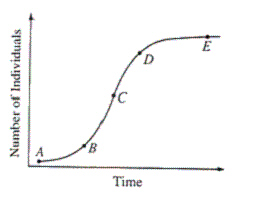
|
|
|
1.
|
Which point on the curve in the diagram above best
represents the carrying capacity of the environment for the population shown?
|
|
|
2.
|
A couple has 5 children, all sons. If the
woman gives birth to a sixth child, what is the probability that the sixth child will be a
son?
a. | 1/64 | b. | 1/6 | c. | 1/5 | d. | 5/6 | e. | 1/2 |
|
|
|
3.
|
Which of the following organelles modifies and
packages for secretion the materials produced by the ribosomes?
a. | The chloroplast | b. | The nucleolus | c. | The Golgi
apparatus | d. | The nucleus | e. | The mitochondrion |
|
|
|
4.
|
Gas exchange in all living organisms
requires
a. | moist membranes | b. | gills | c. | blood | d. | lungs | e. | tracheoles |
|
|
|
5.
|
Which of the following occurs during mitosis, but
NOT during meiosis I?
a. | The diploid number of chromosomes is reduced to the
haploid number. | b. | The nuclear
envelope breaks down. | c. | The chromatids of
each chromosome are separated. | d. | The chromosomes
are pulled to opposite poles by the spindle apparatus. | e. | Both synapsis and crossing-over takes
place. |
|
|
|
6.
|
Oxygen consumption can be used as a measure of
metabolic rate because oxygen is
a. | required by all living
organisms | b. | necessary for ATP synthesis by oxidative
phosphorylation | c. | required to break
down the ethanol that is produced in muscles | d. | necessary to
replenish glycogen levels | e. | necessary for
fermentation to take place |
|
|
|
7.
|
Membranes are components of all of the following
except a
a. | mitochondrion | b. | Golgi apparatus | c. | lysosome | d. | microtubule | e. | nucleus |
|
|
|
8.
|
In animals, all of the following are associated
with embryonic development EXCEPT
a. | inductive tissue interactions | b. | migration of cells to specific areas | c. | formation of germ layers | d. | cell division at a
relatively rapid rate | e. | activation of all
the genes in each cell |
|
|
|
9.
|
Which of the following is primarily responsible for
cell elongation, gravitropism, and apical dominance in plants?
a. | Ethylene | b. | Cytokinin | c. | Auxin | d. | Phytochrome | e. | Gibberellin |
|
|
|
10.
|
Which of the following groups contains prokaryotic
organisms capable of surviving the greatest extremes in temperature or salt
concentration?
a. | Viruses | b. | Protista | c. | Archaebacteria | d. | Plantae | e. | Fungi |
|
|
|
11.
|
Which of the following is LEAST likely to result in
a release of epinephrine (adrenaline) from the adrenal glands?
a. | Swimming in a very cold pool | b. | Falling asleep during a lecture | c. | Going out on a first date | d. | Competing in an athletic event | e. | Taking a test while unprepared |
|
|
|
12.
|
Nuclear division in which the chromosome number is
reduced from 2n to n is part of the life cycle of all of the following organisms except
a. | insects | b. | protozoans | c. | molds | d. | bacteria | e. | ferns |
|
|
|
13.
|
The driving force for the movement of materials in
the phloem of plants is
a. | transpiration of water through the
stomates | b. | gravity | c. | root pressure | d. | a difference in
osmotic potential between the source and the sink | e. | adhesion of water to vessel elements |
|
|
|
14.
|
A tobacco plant can be made to express a gene from
fireflies, resulting in the emission of light. Which of the following is the basis for this
phenomenon?
a. | Fireflies and tobacco plants are infected by the same
kinds of bacteria. | b. | Chloroplasts can
be made to produce light if firefly proteins are injected into plant
cells. | c. | Most enzymes in fireflies have the same amino acid
sequence as the enzymes in tobacco plants. | d. | Fireflies and
tobacco plants share a recent common ancestor. | e. | Transcription and
translation are fundamentally similar in both fireflies and tobacco
plants. |
|
|
|
15.
|
All of the following were likely present on the
primitive Earth during the evolution of self-replicating molecules EXCEPT
a. | simple carbohydrates | b. | amino acids and nucleotides | c. | nitrogen | d. | an oxygen-rich
atmosphere | e. | freestanding
liquid water |
|
|
|
16.
|
During respiration, most ATP is formed as a direct
result of the net movement of
a. | potassium against a concentration
gradient | b. | electrons through a channel | c. | protons down a concentration gradient | d. | electrons against a concentration gradient | e. | sodium ions into the cell |
|
|
|
17.
|
In humans, red-green color blindness is a
sex-linked recessive trait. If a man and a woman produce a color-blind son, which of the
following MUST be true?
a. | Both parents carry the allele for color
blindness. | b. | The father carries
the allele for color blindness. | c. | The father is
color-blind | d. | The mother carries
the allele for color blindness | e. | Neither parent
carries the allele for color blindness. |
|
|
|
18.
|
In a small group of people living in a remote area,
there is a high incidence of "blue skin", a condition that results from the variation in
the structure of hemoglobin. All of the "blue-skinned" residents can trace their
ancestry to one couple, who were among the original settlers of this region. The unusually high
frequency of "blue skin" in the area is an example of
a. | sexual selection | b. | heterozygote advantage | c. | mutation | d. | genetic
drift | e. | natural selection |
|
|
|
19.
|
Which of the following processes is carried out
more efficiently by a C4 plant than by a C3 plant?
a. | Photolysis | b. | Chemiosmotic coupling | c. | Fixation of
CO2 | d. | Transport of
sugars | e. | Light absorption |
|
|
|
20.
|
A number of different phylogenies (evolutionary
trees) have been proposed by scientists. These phylogenies are useful because they can be
used to
a. | demonstrate that natural selection is the prevailing
force in evolution | b. | demonstrate that
all photosynthetic organisms are members of the Kingdom Plantae | c. | determine when two similar populations of a species evolved into two separate
species | d. | demonstrate which taxa (groups of organisms) contain the
most highly evolved species | e. | evaluate which
groups of organisms may be most closely related |
|
|
|
21.
|
Which of the following characteristics is common to
all vascular plants that exhibit an alternation of generations in their life cycle?
a. | Fertilization in water | b. | Diploid spores | c. | Multicellular
sporophytes | d. | Seed
production | e. | Large, independent
gametophytes |
|
|
|
22.
|
Gibberellic acid stimulates the cells of
germinating grass seeds to produce mRNA molecules that code for hydrolytic enzymes. In this
case the role of giberellic acid can best be described as that of
a. | a stimulator of DNA
replication | b. | an activator of
translation | c. | an allosteric
activator of hydrolase | d. | a regulator of
gene activity | e. | a stimulator of
hydrolase secretion |
|
|
|
23.
|
On a sunny day, the closing of stomata in plant
leaves results in
a. | a shift from C3 photosynthesis to
C4 photosynthesis | b. | a decrease in
CO2 intake | c. | an increase in the
concentration of CO2 in mesophyll cells | d. | an increase in transpiration | e. | an increase in the rate of production of
starch |
|
|
|
24.
|
In certain Native American groups, albinism due to
a homozygous recessive condition in the biochemical pathway for melanin is sometimes seen. If
the frequency of the allele for this condition is 0.06, which of the following is the closest to the
frequency of the dominant allele in this population? (Assume that the population is in Hardy-Weinberg
equilibrium.)
a. | 0.94 | b. | 0.16 | c. | 0.04 | d. | 0.06 | e. | 0.36 |
|
|
|
25.
|
Which of the following is the most direct result of
the presence of acid chyme in the small intestine?
a. | The intestinal lining produces the hormone
secretin. | b. | The pancreas produces hydrolytic
enzymes. | c. | The liver produces insulin. | d. | The stomach produces pepsin. | e. | The gall bladder releases bile. |
|
|
|
26.
|
Many parasitic flatworms have an intermediate
host. This indicates that the
a. | flatworms cannot infect
humans | b. | larval flatworms infect only juveniles of a
species | c. | flatworms are microscopic | d. | larval flatworms infect one species, whereas adults infect another
species | e. | flatworm larvae are parasitic on their
parents |
|
|
|
27.
|
Red algae can grow at greater ocean depths than
most other algae can because red algae are
a. | specialized for absorbing ultraviolet wavelengths of
light for photosynthesis. | b. | adapted for
chemosynthesis rather than photosynthesis. | c. | unable to use
chlorophyll for photosynthesis. | d. | specialized for
absorbing blue wavelengths of light for photosynthesis. | e. | specialized for absorbing red wavelengths of light for
photosynthesis. |
|
|
|
28.
|
Which of the following cellular processes is
coupled with the hydrolysis of ATP?
a. | Facilitated diffusion | b. | Na+ influx into a nerve cell | c. | Osmosis | d. | Chemiosmosis | e. | Active
transport |
|
|
|
29.
|
Which of the following cells would most likely have
the greatest concentration of densely packed rough endoplasmic reticulum?
a. | An epithelial cell whose DNA is replicating before
mitosis | b. | A functional phloem cell at
maturity | c. | An amoeba engulfing small
ciliates | d. | A bioluminescent bacterial
cell | e. | A pancreatic cell engaged in the production of digestive
enzymes |
|
|
|
30.
|
In which of the following pairs are the organisms
most closely related taxonomically?
a. | Bacterium…paramecium | b. | Rosebush…diatom | c. | Mushroom…oak
tree | d. | Sea star
(starfish)…clam | e. | Spider…crayfish |
|
|
|
The questions that follow refer to the graph
below. The solid curve and the dashed curve represent alternate pathways for the same reaction.
One pathway is enzyme catalyzed.
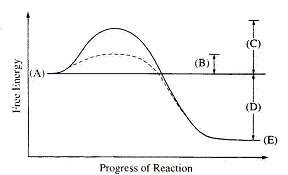
|
|
|
31.
|
Represents the energy state of the products of the
enzyme-catalyzed pathway
|
|
|
32.
|
Represents the energy state of the products of the
pathway that is not enzyme-catalyzed
|
|
|
The questions that follow refer to the following
diagram of angiosperm reproduction.
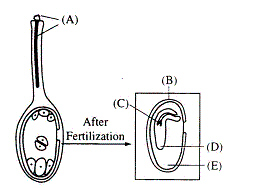
|
|
|
33.
|
Root meristem
|
|
|
34.
|
Apical meristem
|
|
|
35.
|
Seed coat
|
|
|
36.
|
Releases hormones that control blood sugar levels
by stimulating glycogen formation or breakdown
a. | Thyroid | b. | Anterior pituitary | c. | Lining of small
intestine | d. | Pancreas | e. | Testis |
|
|
|
37.
|
This biome has the greatest diversity of
species.
a. | Desert | b. | Taiga | c. | Deciduous
forest | d. | Tundra | e. | Tropical rain forest |
|
|
|
38.
|
This biome is dominated by dwarf shrubs, grasses,
and sedges that can tolerate long dark winters.
a. | Deciduous forest | b. | Tropical rain forest | c. | Desert | d. | Taiga | e. | Tundra |
|
|
|
39.
|
Process found in both photosynthesis and cellular
respiration
a. | Glycolysis | b. | Calvin cycle (light-independent reactions of
photosynthesis) | c. | Light-dependent
reactions of photosynthesis | d. | Chemiosmosis | e. | Krebs cycle
(citric acid cycle) |
|
|
|
40.
|
Bilaterally symmetrical; deuterostome; dorsal
hollow nerve cord
a. | Arthropoda | b. | Chordata | c. | Echinodermata | d. | Annelida | e. | Mollusca |
|
|
|
41.
|
Process that results in the production of cDNA from
an RNA molecule
a. | Translation | b. | Reverse transcription | c. | Replication | d. | Transformation | e. | Transcription |
|
|
|
42.
|
Process in which RNA is produced by using a DNA
template
a. | Translation | b. | Reverse transcription | c. | Transcription | d. | Transformation | e. | Replication |
|
|
|
The questions that follow refer to the information
below
|
|
|
43.
|
The scientist used restriction enzymes for what
purpose in the experiment?
a. | To enable the fragments of DNA to form covalent
bonds | b. | To make cuts in the plasmid
DNA | c. | To enable the plasmid to recognize the bacterial
cells | d. | To make the plasmid small enough to transform
cells | e. | To make the plasmid enter the
cells |
|
|
|
44.
|
If the scientist had forgotten to use DNA ligase
during the preparation of the recombinant plasmid, bacterial growth would most likely have occurred
on which of the following?
a. | 1 and 2 only | b. | 4 and 5 only | c. | 1,2, and 3
only | d. | 1 and 4 only | e. | 4,5, and 6 only |
|
|
|
45.
|
If the scientist used the cultures to perform
another experiment as shown below, using medium that contained lactose as the only energy source,
growth would most likely occur on which of the following plates?
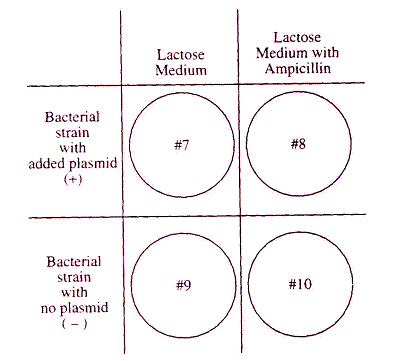
a. | 9 and 10 only | b. | 10 only | c. | 7 and 9
only | d. | 8 and 10 only | e. | 7 and 8 only |
|
|
|
46.
|
In a study of the development of frogs, groups of
cells in the germ layers of several embryos in the early gastrula stage were stained with five
different dyes that do not harm living tissue. After organogenesis (organ formation), the
location of the dyes was noted, as shown in the table at right:
| Tissue | Stain | | Brain | Red | | Notochord | Yellow | | Liver | Green | | Lens of the eye | Blue | | Lining of the digestive tract | Purple | | |
Ectoderm
would eventually give rise to tissues containing which of the following colors?
a. | Red and blue | b. | Purple and green | c. | Green and
yellow | d. | Green and red | e. | Yellow and purple |
|
|
|
47.
|
A woman with blood type B gives birth to a child
with blood type A. The father must have which of the following blood types?
a. | Either AB or A | b. | Either AB or O | c. | AB
only | d. | AB or A or O | e. | Either AB or B |
|
|
|
The questions that follow refer to the following
graphs.
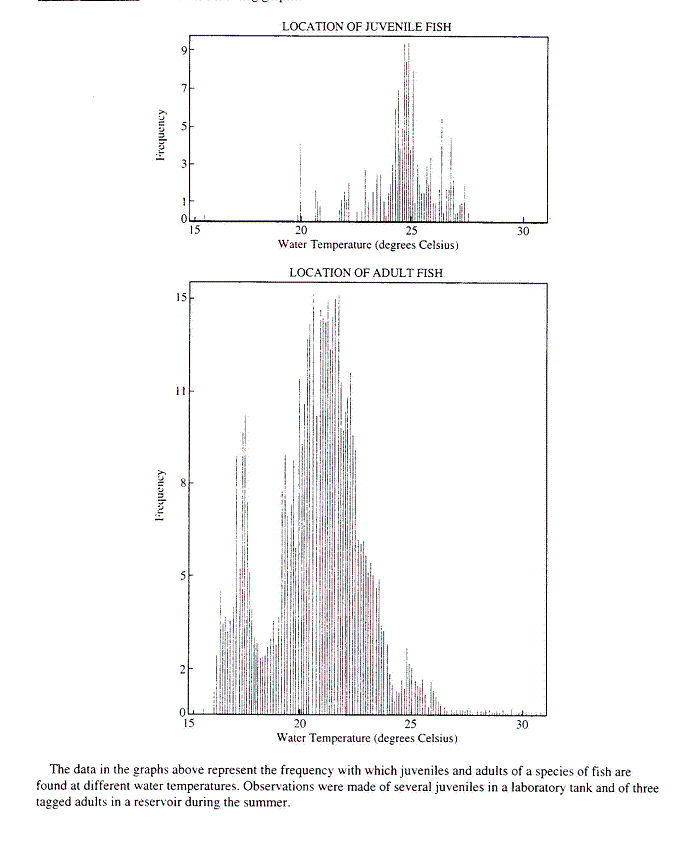
|
|
|
48.
|
The most accurate conclusion to be drawn solely
from the graphs is that
a. | the oxygen content of warm water is higher than that of
cool water | b. | the oxygen content
of cool water is higher than that of warm water | c. | adult fish of this
species are found more frequently in water at 22oC than are juveniles | d. | fish of this species are found most frequently in water at
20oC | e. | the optimum temperature for fish of this species is
25oC |
|
|
|
49.
|
Which of the following statements about the results
is true?
a. | They are inconclusive because too few fish were
used. | b. | They are inaccurate because tanks with temperature
gradients were used. | c. | They are invalid,
because part of the experiment was not done in the laboratory. | d. | They are improperly graphed, because the dependent variable is on the
horizontal (x) axis. | e. | They are invalid
because the data show too much variation. |
|
|
|
The questions that follow refer to the following
table.

|
|
|
50.
|
Which of the animals is most likely to have, living
in specialized areas of its digestive tract, abundant symbiotic bacteria that break down foods that
the animal normally could not digest on its own?
|
|
|
51.
|
Which animal has a gastrovascular
cavity?
|
|
|
52.
|
Which animal is most efficient in absorbing the
food it consumes?
|
|
|
The questions that follow refer to an experiment
that was performed to separate DNA fragments from four samples radioactively labeled with
32P. The fragments were separated by gel electrophoresis. The visualized bands
are illustrated in the figure below. 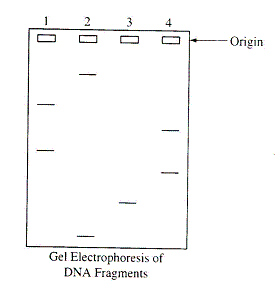
|
|
|
53.
|
The DNA was labeled with 32P in order
to
a. | stimulate DNA replication | b. | inhibit the uptake of unlabeled ATP | c. | visualize the fragments | d. | show wich
fragments included the 5' end and which fragments included the 3'
end | e. | speed up the rate of separation by
electrophoresis |
|
|
|
54.
|
Which of the following is an additional use of the
gel electrophoresis technique?
a. | To separate proteins in a
mixture | b. | To amplify genes | c. | To ligate DNA fragments | d. | To transform E.
coli | e. | To express a gene |
|
|
|
The questions that follow refer to an experiment in
which a dialysis-tubing bag is filled with a mixture of 3% starch and 3% glucose and placed in a
beaker of distilled water, as shown below. After 3 hours, glucose can be detected in the water
outside the dialysis tubing, but starch cannot. 
|
|
|
55.
|
From the initial conditions and results described,
which of the following is a logical conclusion?
a. | A net movement of water into the beaker has
occurred. | b. | The molarity of the solution in the bag and the molarity
of the solution in the surrounding beaker are the same. | c. | The initial concentration of glucose in the bag is higher than the initial
concentration of starch in the bag. | d. | The pores of the
bag are larger than the glucose molecules but smaller than the starch
molecules. | e. | The bag is not
selectively permeable. |
|
|
|
56.
|
Which of the following best describes the condition
expected after 24 hours?
a. | The bag will contain more water than it did in the
original condition. | b. | Starch molecules
will continue to pass through the bag. | c. | Water potential in
the bag will be greater than water potential in the surrounding solution. | d. | The contents of the bag will have the same osmotic concentration as the
surrounding solution. | e. | A glucose test on
the solution in the bag will be negative. |
|
|
|
57.
|
If, instead of the bag, a potato slice were placed
in the beaker of distilled water, which of the following would be true of the potato
slice?
a. | It would lose water until water potential inside the
cells is equal to zero. | b. | It would neither
gain nor lose mass. | c. | It would gain
mass. | d. | The cells of the potato would increase their metabolic
activity. | e. | It would absorb solutes from the surrounding
liquid. |
|
|
|
The graph below shows changes in a population of
wild sheep that were introduced to the island of Tasmania in the early 1800’
|
|
|
58.
|
The type of population growth represented by that
portion of the graph line enclosed in the bracket is most accurately termed
a. | arithmetic | b. | decelerating | c. | exponential | d. | density-dependent | e. | stable |
|
|
|
59.
|
The graph indicates that the sheep population most
likely is
a. | growing in excess of its carrying capacity, since
fluctuations in population size occurred after 1850 | b. | headed for extinction because of the population explosion about
1930 | c. | shifting from a K-selected to an r-selected
strategy | d. | regulated by density-independent factors, because there
appears to be about a 10-year cycle of sharp declines in size | e. | stable after 1850 under the effects of density-dependent regulating
factors |
|
|
|
60.
|
In the graphs below, the solid line represents the
original population. The dotted line on which graph best represents the sheep population that
would have resulted from a sustained increase in the primary productivity of the environment?
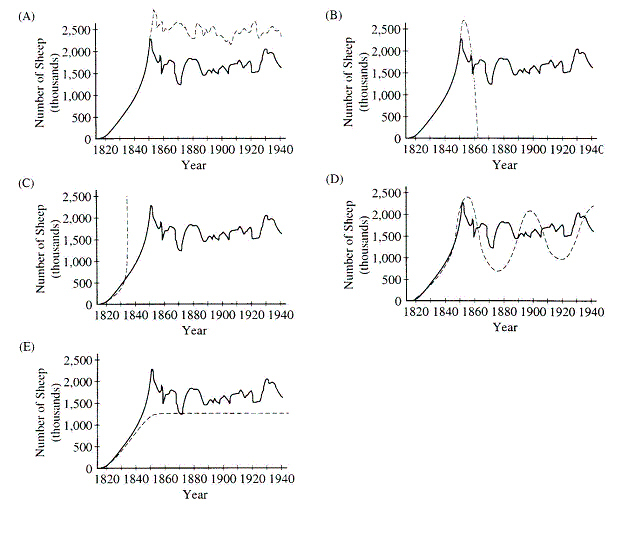
|